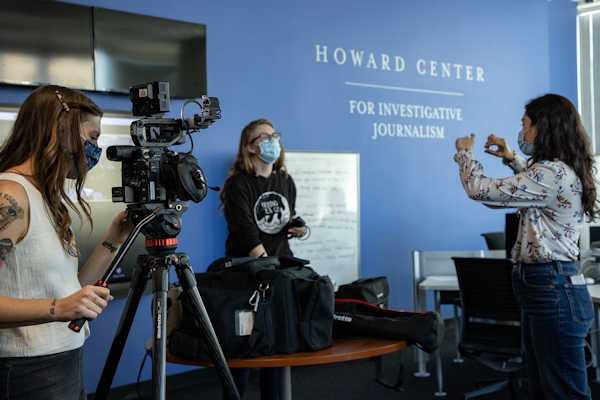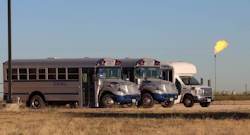SEJournal Online is the digital news magazine of the Society of Environmental Journalists. Learn more about SEJournal Online, including submission, subscription and advertising information.
 |
 |
| The student team in the newsroom as they prepare equipment and get ready for a reporting trip to Texas. Photo: “Gaslit” project. |
EJ Academy: 'Gaslit' Project Spotlights Challenges of Teaching Investigative Journalism
By Bob Wyss
The 17 students at Arizona State University began their investigation of the natural gas industry with a lesson in what not to do.
“The first thing we all want to do is pick up the phone,” explained Maud S. Beelman, the founding executive editor of ASU’s Howard Center for Investigative Journalism. Instead of calling potential sources, students were told to “do the research. Read lots of science studies, get up to speed on the science.”
The result was “Gaslit,” an investigation that showed that the amount of greenhouse gases being released by the natural gas industry is far above what government regulators know and permit.
The series won first prize for outstanding student reporting in the Society of Environmental Journalists’ 22nd annual environmental reporting awards, and an honorable mention in the Nina Mason Pulliam Award. The satellite database used by the students was also explored in a Dec. 13 SEJournal Reporter’s Toolbox.
All the work done by students
Investigative reporting may be the crown jewel of journalism but teaching it can be a challenge, agreed Beelman, a former U.S. investigative editor for The Associated Press who supervised “Gaslit” as a project editor along with Loren Mucciolo, executive producer at the Howard Center and a former producer at PBS Frontline.
 |
| Natural gas flaring in North Dakota. Photo: “Gaslit” project. |
“Investigative journalism is a whole different beast,” said Beelman.
Besides mastering a range of journalistic tools from understanding arcane research to conducting data analysis, investigations take time. The investigations conducted by students in the Howard Center, begun at ASU in January 2019 with Beelman, had an additional burden. Like anything else in an academic journalism program, all of the work had to be done by the students.
The idea for “Gaslit” began in an “Introduction to Investigative Journalism” class when a student found a story about how excess natural gas was being burned, or flared, based on a study by a Texas A&M researcher. From there, it was explored further in a Spring 2022 class designed to develop ideas for major investigations.
By now work begun by a scientist at the National Oceanic and Atmospheric Administration (and later the Colorado School of Mines) on satellite data was able to document the amount of gas being flared at specific sites. A student that summer did further work analyzing the satellite data.
“They did a great job in laying the foundation for the investigation,” said Beelman.
One term to wrap the investigation
In the fall, the 17 students enrolled in a nine-credit, full-time, capstone class. They were primarily graduate students, including recent graduates, students who had worked in journalism and those from other disciplines who wanted to transition into journalism. They had one semester to complete their investigation.
‘It’s always hard to know what
students will walk in the door.’
— Loren Mucciolo
“It’s always hard to know what students will walk in the door,” said Mucciolo, who as the executive producer is responsible for the more visual aspects of the production. In this case, the crew included two talented photographers, one with a license to pilot drones, as well as another student experienced in computer programming.
None of the students had a background in science or environment but their early research led to the discovery of three different types of datasets for gas flaring and venting. One was the satellite data, a second were various data sets compiled by the states and a third was a database compiled by the U.S. Energy Information Administration. All of these databases varied in the amount of gas flared and vented.
The students broke up into teams responsible for finding out what impacts the flaring was having on health and on the environment, as well as teams looking into the economics and the flaring data itself. They took weeklong field trips to Texas, North Dakota and New Mexico.
Faculty did not accompany them. “They do check in daily, by phone and text,” said Mucciolo. “We talk to them late at night and early in the morning.”
Collaborating, humanizing
By now it was clear that the regulators' data clearly did not match the higher level of emissions revealed by the satellite data. By midsemester students had to begin writing drafts of their findings. While huge holes remained, students were on a tight deadline. “Maximizing our time is one of our biggest challenges,” said Mucciolo.
One solution is collaboration, which Beelman said is deeply embedded into the course. The reason — professional investigations have become increasingly complex, often involving reams of computer data and reporters from multiple news organizations.
Such partnerships are also important from a teaching standpoint, added Mucciolo, because “some students do not know how to collaborate.” Now, that requirement is part of the syllabus. “It’s a skill,” she added, “It’s an art form.”
‘Finding the humans,
finding something to make
people care, is important.’
— Maud Beelman
Another major teaching objective is to humanize the story and make it important to the audience. “Finding the humans, finding something to make people care, is important,” said Beelman.
The field trips were vital to that objective. In Texas, students were struck by how dependent state regulators were on the industry, as opposed to the science, in understanding the emissions. In North Dakota, the impact was on the Native American tribes, so their proximity to the gas fields became a key element in the story.
“The reporting may be complicated,” said Beelman, “but the storytelling has to be simple.”
Tapping visual skill sets
Photos of flaring at night helped dramatically illustrate the project. Also, the drone photography vividly displayed in the accompanying documentary was especially revealing.
Besides the print stories, photos and the nine-minute documentary, the students produced an interactive map, as well as datasets from the 13 states where flaring and venting of gas is significant. A detailed explanation of the methodology behind the project was also published.
“We built all of the elements using the skill sets of all of our students,” said Mucciolo.
By the last two weeks of the semester, the production of all the pieces of the investigation had to be finished and students began the fact-checking.
“Every component is checked; we have the students do it,” said Mucciolo.
The series was published in early 2022 and since then the students have graduated and left for new opportunities. While Mucciolo remains at ASU, Beelman is in the process of retiring and has a part-time role with the Howard Center.
By fall 2022 flaring was receiving new attention from the U.S. Department of the Interior, which announced new rules to curb the burning of excess natural gas at extraction sites.
That development, as well as the awards, points to the study’s impact. Yet by the end of the semester, it had become an exhausting project, one that caused headaches for leaders such as Mucciolo. “The massiveness of this project,” she said, “was part of the challenge.”
Bob Wyss is co-editor of SEJ Academy, a quarterly column for environmental journalism educators and students. He is a professor emeritus of journalism at the University of Connecticut and is writing his fifth book.
* From the weekly news magazine SEJournal Online, Vol. 9, No. 8. Content from each new issue of SEJournal Online is available to the public via the SEJournal Online main page. Subscribe to the e-newsletter here. And see past issues of the SEJournal archived here.













 Advertisement
Advertisement 



